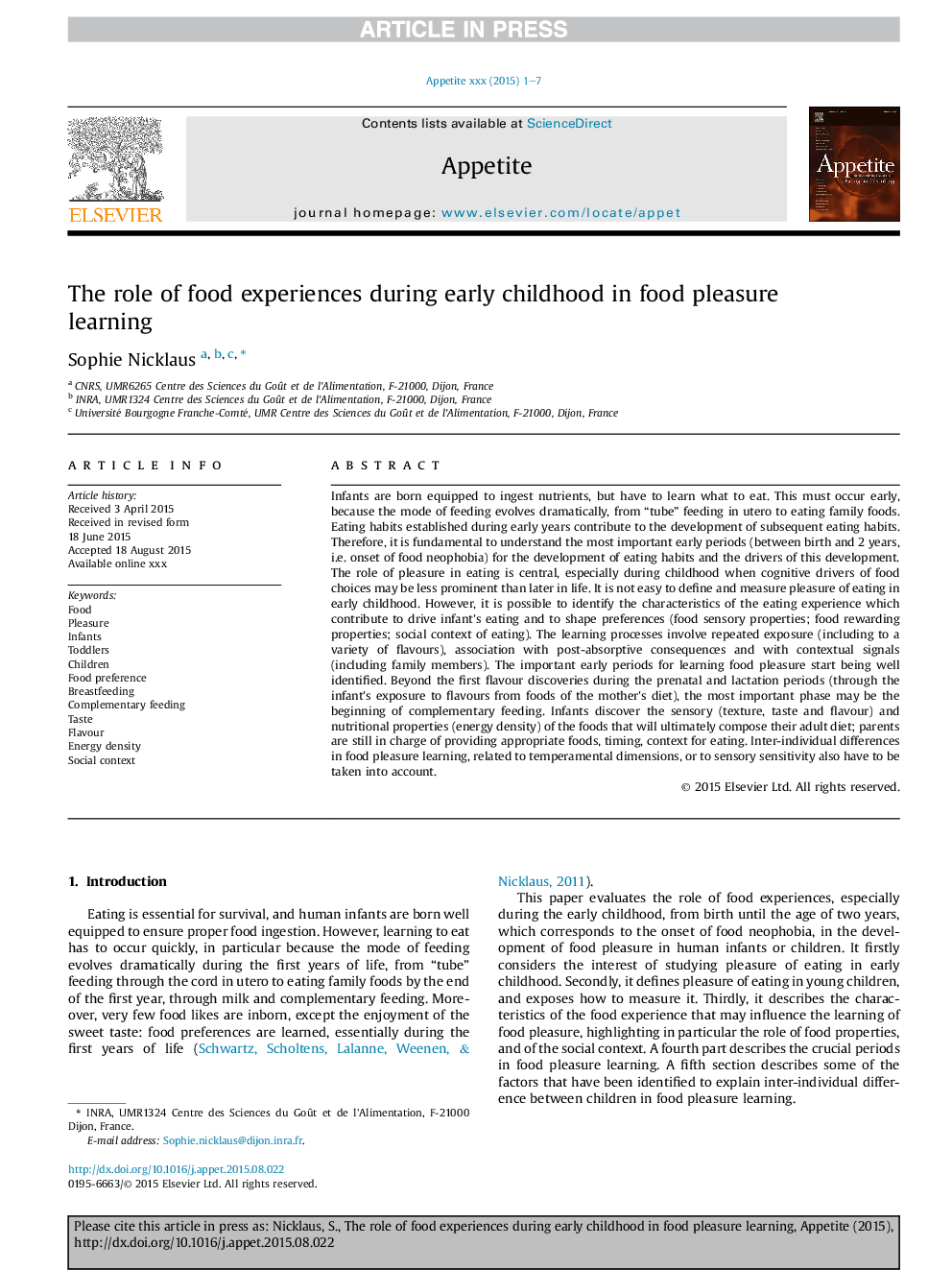| کد مقاله | کد نشریه | سال انتشار | مقاله انگلیسی | نسخه تمام متن |
|---|---|---|---|---|
| 7306910 | 1475376 | 2016 | 7 صفحه PDF | دانلود رایگان |
عنوان انگلیسی مقاله ISI
The role of food experiences during early childhood in food pleasure learning
ترجمه فارسی عنوان
نقش تجارب غذا در دوران کودکی در یادگیری لذت مواد غذایی
دانلود مقاله + سفارش ترجمه
دانلود مقاله ISI انگلیسی
رایگان برای ایرانیان
کلمات کلیدی
غذا، لذت، نوزادان، کودک نو پا، فرزندان، ترجیح غذا، شیر دادن، تغذیه تکمیلی، طعم عطر و طعم، تراکم انرژی، زمینه اجتماعی،
ترجمه چکیده
نوزادان متولد شده اند تا مواد مغذی مصرف کنند، اما باید یاد بگیرند که چه چیزی بخورند. این باید در اوایل رخ دهد، زیرا حالت تغذیه به طرز چشمگیری تحریک می شود، از یک لوله؟ تغذیه در رحم برای خوردن غذاهای خانواده. عادت های غذائی که در طول سال های اولیه ایجاد شده، به توسعه عادات غذائی بعد کمک می کند. بنابراین، مهم است که مهم ترین مهم ترین دوره های زود هنگام (بین تولد و 2 سال، یعنی ابتدای نئوفوبیا مواد غذایی) را برای توسعه عادات غذا و رانندگان این پیشرفت درک کنید. نقش لذت در خوردن غذا مهم است، به خصوص در دوران کودکی، زمانی که رانندگان شناختی انتخاب غذا ممکن است کمتر از حیوانات بعد از آن برجسته باشند. لذت خوردن غذا در اوایل کودکی آسان نیست. با این حال، می توان ویژگی های تجربه غذا را تشخیص داد که باعث می شود سبب تغذیه نوزاد و شکل دادن به ترجیحات (خواص خواص غذایی، خواص پاداش غذا، بستر اجتماعی غذا) شود. فرایندهای یادگیری شامل مواجهه تکراری (از جمله با انواع طعم دهنده ها)، ارتباط با پیامدهای پس از جذب و با سیگنال های متنی (از جمله اعضای خانواده) است. دوره های اولیه مهمی برای لذت بردن از لذت مواد غذایی به خوبی شناخته شده است. فراتر از اولین کشف عطر و طعم در دوره های قبل و بعد از شیردهی (از طریق قرار گرفتن شیر مادر از مواد غذایی رژیم غذایی مادران)، مهمترین مرحله ممکن است شروع تغذیه مکمل باشد. نوزادان حساسیت (بافت، طعم و عطر و طعم) و خواص تغذیه ای (تراکم انرژی) مواد غذایی را که در نهایت رژیم بالغ خود را تشکیل می دهند، کشف می کنند. پدر و مادر هنوز هم مسئول غذای مناسب، زمان بندی، زمینه برای خوردن هستند. تفاوت های بین فردی در یادگیری لذت بردن از غذا، مربوط به ابعاد ظاهری یا حساسیت حسی نیز باید مورد توجه قرار گیرد.
موضوعات مرتبط
علوم زیستی و بیوفناوری
علوم کشاورزی و بیولوژیک
دانش تغذیه
چکیده انگلیسی
Infants are born equipped to ingest nutrients, but have to learn what to eat. This must occur early, because the mode of feeding evolves dramatically, from “tube” feeding in utero to eating family foods. Eating habits established during early years contribute to the development of subsequent eating habits. Therefore, it is fundamental to understand the most important early periods (between birth and 2 years, i.e. onset of food neophobia) for the development of eating habits and the drivers of this development. The role of pleasure in eating is central, especially during childhood when cognitive drivers of food choices may be less prominent than later in life. It is not easy to define and measure pleasure of eating in early childhood. However, it is possible to identify the characteristics of the eating experience which contribute to drive infant's eating and to shape preferences (food sensory properties; food rewarding properties; social context of eating). The learning processes involve repeated exposure (including to a variety of flavours), association with post-absorptive consequences and with contextual signals (including family members). The important early periods for learning food pleasure start being well identified. Beyond the first flavour discoveries during the prenatal and lactation periods (through the infant's exposure to flavours from foods of the mother's diet), the most important phase may be the beginning of complementary feeding. Infants discover the sensory (texture, taste and flavour) and nutritional properties (energy density) of the foods that will ultimately compose their adult diet; parents are still in charge of providing appropriate foods, timing, context for eating. Inter-individual differences in food pleasure learning, related to temperamental dimensions, or to sensory sensitivity also have to be taken into account.
ناشر
Database: Elsevier - ScienceDirect (ساینس دایرکت)
Journal: Appetite - Volume 104, 1 September 2016, Pages 3-9
Journal: Appetite - Volume 104, 1 September 2016, Pages 3-9
نویسندگان
Sophie Nicklaus,
